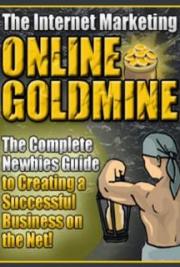Chapter 6
A Few More Great and Not So Great Ideas
We’ve discussed the best ideas when it comes to free traffic generation, SEO, social networking, viral content and email marketing. Now we’re going to consider some other avenues that might work well for your business—depending of course on the business model and on your strategy. Remember, you’re looking for free here…and really, free is the best to do, as all of the most effective methods we covered are free.
So the idea of paying for traffic, or paying for impressions, is not a great one—unless you can afford it, and unless you can develop a budget and a strategy to make it worth your investment.
Banner Advertising
Take banner advertising for instance. Usually, this involves paying a website to host your banner ad, and when a user clicks on it, he or she is directed back to your site. This is the relatively cheap cyber equivalent of a commercial—something that’s relatively targeted (at least in demographical information; i.e. advertising baby products on a site that caters to new moms) but still not as targeted as search engine traffic— which actually penetrated the user’s mind, and uses the same keywords he or she is thinking.
Of course, banner advertising does not have to be paid advertising. Here’s an idea: create multiple sites (but do NOT duplicate content) and then place banner ads taking your users from one site to the next. Or, you could barter with other websites in exchange for a banner ad. Banner ads don’t really count in estimating overall links (the stuff that gets you high ranked), at least not to the extent that organic SEO links can.
However, if you have an artistic or commercial design skill, you may find it useful to go ahead and create a banner ad using fancy font text (still appropriate to your site theme) or other decorative shapes or objects. In general, avoid GIF animation, and opt instead for Flash or another dynamic technology. Of course, some users hate flashing banners altogether, regardless of technology. Keep banners simple and make sure you convey a message…not merely an attitude or a thought that leads nowhere.
There are “standards” of banner sizes to consider. Here are standard sizes to choose from:
468 x 60 Full Banner
728 x 90 Leaderboard
336 x 280 Square
300 x 250 Square
250 x 250 Square
160 x 600 Skyscraper
120 x 600 Skyscraper
120 x 240 Small Skyscraper
240 x 400 Fat Skyscraper
234 x 60 Half Banner
180 x 150 Rectangle
125 x 125 Square Button
120 x 90 Button
120 x 60 Button
88 x 31 Button
In addition to trading banners with other companies, networks or search directories, you can also set up banners for affiliate network opportunities or even for self promotion. So yes, it is a smart idea to create a banner now before you suddenly find out that you need one and have nothing in the works!
Ad Swaps / Link Exchanges
Speaking of trading links, is it true that trading banners or text links with another company similar to your own (or in a related field) is a waste of time? Not exactly. True, there has been a lot of publicity lately stating, in so many words, that link exchanges are not as effective as you once thought them to be. And this makes perfect sense.
Consider, that for a while, many poor marketers online were creating “mutual benefit” link exchanges with each other in hopes of artificially inflating their external links—and thus getting special attention from Google for being a high PR site. That’s not really the same thing as a small company that actually works hard for its links by creating press releases, blogs, articles for directories and other mediums.
So yes, many SEO “experts” were stopped dead in their tracks as Google and other big wigs informed the world that link exchanges are simply not valuable in most cases.
Namely, when companies just use them as a means of leverage.
This is not to say that mutual link exchanges are always a bad thing. When there is a good reason for a link exchange, as in a “blog roll” of authors who write on the same subject, then the search engines will count that as a legitimate link. In some cases, mutual link exchanges may work…but only if you prove to search engines that you are actually working together (such as, guest blogging) and are not mindlessly exchanging links for cheap traffic boosting purposes.
PPC Advertising / Text Links
PPC is usually not something associated with free web traffic generation…because by nature it costs companies to use its technology. This is an alternative to SEO, and while it does use similar logic to the search engine algorithm, it is more about whoever bids the most per click.
Not only do you publicize your company through text ads, but you also benefit by “impressions”, which are the number of times your company text (or banner) is seen by an online audience. They don’t have to “click” to get an idea of who you are. PPC companies (like as Google and Facebook, the two most well known examples) make money not only by the total number of clicks you pay for, but also because they demand a high impression count so that they continue to make money.
How does this concern you as a business owner going after free traffic?
First, there are free introductory PPC deals you can look into. Why, even some web hosts are now giving away $50-100 of free text ads. There are also true-blue free PPC sites out there, such as seen at Squidoo (a popular directory that lets you create individual web pages).
Of course, “free PPC” is only a few steps away from “affiliate linking” opportunity (our next topic to discuss), since both methods involve trading clicks and impressions from one company to another. Of course, with affiliate networks, you also have the option of making money or paying money.
Affiliate Programs and Joint Venture Campaigns
Affiliate programs, in this context, do not exclusively refer to an affiliate sales program such as the one offered by Amazon.com; though some programs are interconnected through a single network. Rather, it means that you can associate yourself with a network and benefit from their traffic boosts—while also earning money for your traffic or paying money to receive more traffic.
In essence, it is a glorified version of a link exchange, with some pivotal differences. An affiliate program acts as an intermediary between web publishers (known as the affiliates) and retailers who want to sell their products. You may choose either role if you sign up with an affiliate…though you will only be able to work within the network.
You must also abide by the terms of the network as far as content goes, though you can negotiate various issues such as banner sizes and placements, text ads, anchor text ads and various other options.
You can benefit from the popularity of other websites within the network and enjoy a blog-like community dynamic when you sign up for an affiliate program. The only thing is, you have to consider questions such as: Does my site fit the theme of the other sites on the network? (This is not only important for branding purposes, but also for traffic, since you are only going to receive benefits if you can interest users from those other sites.)
Basically, with an affiliate program you can expose your website to more traffic sources and reach a larger, hopefully more mainstream audience. Of course, the retailer is only interested in promoting the program to the publishers who are doing publicity for the products.
Of course, revenue sharing and Cost-Per-Click or Cost Per Impression models are not of prime importance to you, not if you want to earn traffic the fastest and most effective way. The bottom line is that you can take your website and your stats directly to advertisers and make more money without any content restrictions or other annoying rules that you might encounter at an affiliate network.
Many entrepreneurs have worked with affiliate networking programs and passed their minimum traffic requirements…only to realize that there wasn’t much money to be gained besides a few pennies a day. That, together with the fact that only hanging large banners on your site seems to increase revenue—and that this may be in violation of new search engine standards—make this a questionable opportunity
Joint Venture opportunities are similar to link exchanges and affiliate marketing but only involve working with one or more large companies and establishing your own sort of mutually beneficial “network”. Once again, this will only prove effective if you focus on joint content development, or perhaps guest blogging. Keep things interesting and don’t let the links do all the talking. Make sure you including some interesting text and anchor text along with your links.
Giving Away Free Stuff
If worse comes to worst, you could always offer direct incentives to your audience in exchange for their visit. For example, free giveaways, free coupons, free meals and so on. Honestly, it is a good and fast way to boost popularity and website traffic— especially if you’re giving away something truly amazing. (The best way to do it is to start the fire on your social networking page and then direct them to your homepage for contest details and entry forms) Big traffic all around with this approach.
However, don’t fall into the trap of paying for traffic—as in spending more money on gifts than you actually make. What many web entrepreneurs and store owners are trying right now is the gift of knowledge—the gift of viral content. It only costs you time and that could be cheaper than giving away a lot of expensive prizes.
Then again, if writing 10 free articles costs you more in time than buying a few customized company hats, then maybe it’s time to reevaluate the situation.
Local and Mobile (Free) Advertising
Lastly, we come to the next big thing in traffic: local and mobile advertising. Who would have thought that computers and the almighty Windows OS would play second banana to cell phones, Smartphones, and Linux and Apple-based operating systems?
Indeed, many people are using Internet ready cell phones, e-readers and multimedia players…and are ditching their computers entirely. (Or at least keeping them locked away in a distant armoire somewhere). Take advantage of this. Chase your audience wherever they go—even if they go mobile.
Mobile marketing exclusively focuses on mobile device users, and involves creating content, links, apps and text messages for traveling users. Much of this effort will be in creating text messages for marketing (which will be similar to social networking status messages), since users on the go don’t really have time to read articles. (Although some websites do find it advantageous to create a mobile app or a mobile version of the site for better loading time)
However, it combines the theory behind email marketing as well, as you are focusing attention on subscribers to your texts. (And you also want to use the double opt in system for this, since people will NOT appreciate SPAM text messages)
Lastly, consider the new technology of local marketing, made possible through mobile devices which can localize all of your Internet information. The biggest local sites to consider for your mobile marketing campaign include:
- Google Maps
- Facebook Places
- Google Places
Signing up at all of these sites can help you to reach the attention of people within your local vicinity. Google Maps takes advantage of localization features and can actually direct local web traffic using mobile devices to your company because of your close proximity.
One of the newest Google algorithm updates, Venice, helps to increase the SERPs of local companies in the area who are creating content for local customers. Google Places and Facebook Places are search engine giants for local business, and can help direct mobile traffic and regular web traffic towards your company based solely on where you (and the target customer) are located.
Conclusion
We have learned a lot about earning traffic for free throughout this book. How great it is to know that you don’t have to spend thousands of dollars, and be subject to the whims of a publicity firm or marketing company just to reach your targeted audience. In fact, you can reach out to your local or national community simply by using the free Internet tools that are available to you.
The key to success is being active and being ambitious. Stay persistent and connect with your wonderful world of customers for the best success. Thanks for reading!







